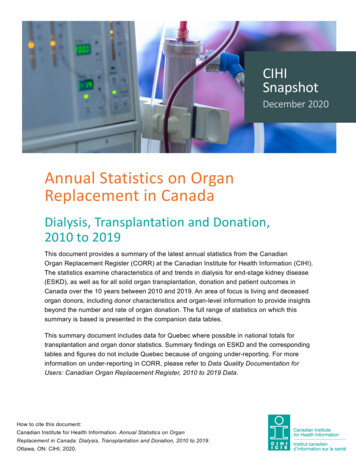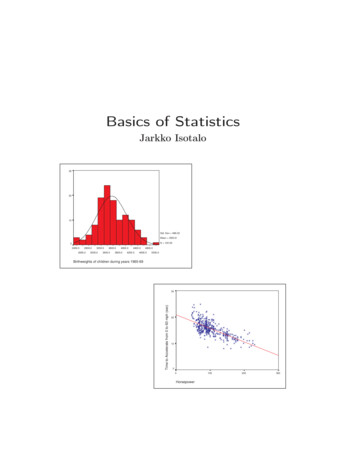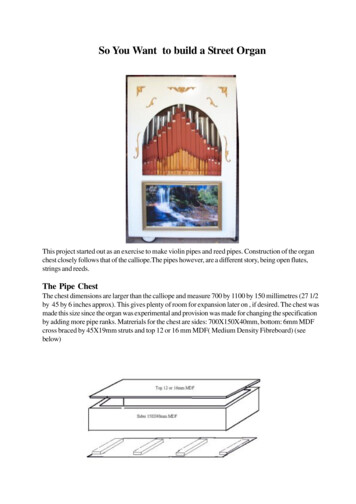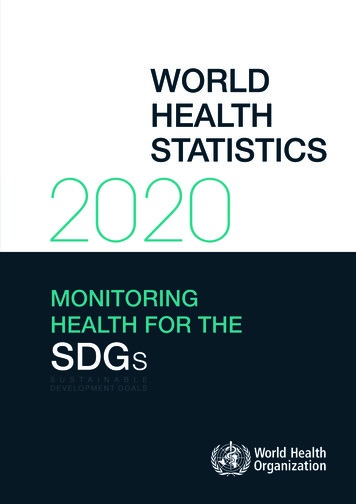
Transcription
CIHISnapshotDecember 2020Annual Statistics on OrganReplacement in CanadaDialysis, Transplantation and Donation,2010 to 2019This document provides a summary of the latest annual statistics from the CanadianOrgan Replacement Register (CORR) at the Canadian Institute for Health Information (CIHI).The statistics examine characteristics of and trends in dialysis for end-stage kidney disease(ESKD), as well as for all solid organ transplantation, donation and patient outcomes inCanada over the 10 years between 2010 and 2019. An area of focus is living and deceasedorgan donors, including donor characteristics and organ-level information to provide insightsbeyond the number and rate of organ donation. The full range of statistics on which thissummary is based is presented in the companion data tables.This summary document includes data for Quebec where possible in national totals fortransplantation and organ donor statistics. Summary findings on ESKD and the correspondingtables and figures do not include Quebec because of ongoing under-reporting. For moreinformation on under-reporting in CORR, please refer to Data Quality Documentation forUsers: Canadian Organ Replacement Register, 2010 to 2019 Data.How to cite this document:Canadian Institute for Health Information. Annual Statistics on OrganReplacement in Canada: Dialysis, Transplantation and Donation, 2010 to 2019.Ottawa, ON: CIHI; 2020.
Annual Statistics on Organ Replacement in CanadaCIHI SnapshotKey findings There were 40,734 Canadians (excluding Quebec) living with ESKD at the end of 2019, an increaseof 33% since 2010. Looking at all solid organs, the deceased organ donor rate in Canada in 2019 (including Quebec) was21.8 donors per million population, an increase of 59% since 2010. The living donor rate was 16.3 donorsper million population, approximately the same as in 2010. In 2019, a total of 3,014 transplant procedures (all organs) were performed in Canada (including Quebec),an increase of 42% since 2010.Table Organs transplanted, waiting lists and deaths on waiting list,by organ, Canada including Quebec, as of December 31, 2019*Organ typeNumber oforgans transplantedNumber of patients on waiting listNumber of patientswho died on waiting 85249KidneyPancreasTotal†Notes* This includes aggregate data from Transplant Québec to supplement national totals. Waiting list statistics for simultaneouskidney–pancreas (SKP) transplants are included in the pancreas section.† The Total row includes intestines and other (non-SKP) combination organ transplants.SourceCanadian Organ Replacement Register, 2020, Canadian Institute for Health Information.Transplantation and donation in CanadaiIn 2019, a total of 3,014 transplant procedures were performed in Canada (including Quebec), 229 morethan in 2018. The number of transplants performed had increased over the previous 5 years, up from2,359 in 2014. The 3,014 transplant procedures performed in 2019 resulted in the transplant of 3,084 solidorgans. There were 4,352 people on a waiting list for an organ transplant, including 2,685 who were activeon the list. In total, 249 people died while waiting for a transplant.In 2019, there were 820 deceased organ donors in Canada (including Quebec), 58 more than the762 reported in 2018. In addition, there were 614 living organ donors. i.Of the 820 deceased donors, 71% were donation after brain death (NDD, or neurological determinationof death) and 29% were donation after cardio-circulatory death (DCD) (see the figure below). Over the10 years studied, NDD donors increased by 37%, whereas DCD donors increased by 471%.This section includes aggregate data from Transplant Québec to supplement national totals.2
Annual Statistics on Organ Replacement in CanadaCIHI Snapshot The deceased donor rate was 21.8 donors per million population, an increase of 59% since 2010.This rate is comparable with rates in Australia (21.6 per million population) and the United Kingdom(24.9 per million population).1 The living donor rate was 16.3 donors per million population. Canada has one of the higher livingdonation rates compared with other countries, but this rate has been approximately the same since 2010. The number of deceased donors increased 76% over the 10 years, from 466 in 2010 to 820 in 2019.The number of living donors was mostly steady over the same time period. 61% of deceased donors (excluding Quebec) were male. The average number of organs used fortransplantation was 3 for all deceased donors and 4 for those age 39 and younger. 62% of living donors (excluding Quebec) were female. 57% of living organ donors were unrelated tothe transplant recipient.Figure Number of donors, by donor type and year, Canada includingQuebec, 2010 to 2019900800Number of e of donor20142015DCD2016Living201720182019Deceased sed (NDD and 21538585553563544535555614LivingNotesNDD: Neurological determination of death (donation after brain death).DCD: Donation after cardio-circulatory death.1 deceased donor in 2018 had missing data regarding donor type (NDD or DCD) and was excluded.SourceCanadian Organ Replacement Register, 2020, Canadian Institute for Health Information.3
Annual Statistics on Organ Replacement in CanadaCIHI SnapshotEnd-stage kidney disease in CanadaTrends in end-stage kidney diseaseThe need for renal replacement therapy in Canada is growing. The rate of new patients per millionpopulation starting renal replacement therapy increased on average 1.6% per year between 2010 and 2019.The 2019 rate in Canada (excluding Quebec) was 208 new patients per million population, with Manitoba andNewfoundland and Labrador having the highest rates of new patients per million population: 269 and 249,respectively. The number of patients receiving dialysis nearly doubled over 20 years, from 11,601 in 2000 to23,125 in 2019. Of the 23,125 patients on dialysis last year, three-quarters were receiving institutionalhemodialysis, the most expensive treatment option. Patients with ESKD in Canada who receive a transplantfrom a deceased donor will spend an average of 3.7 years on dialysis before receiving a transplant.There is also positive progress in Canada. Between 2010 and 2019, there was a 15% increase in theproportion of new patients starting on a home dialysis therapy. The proportion of patients with late referral —those first seen by a nephrologist less than 90 days before starting dialysis — decreased from 30% to25% over the same time period. Another measure of quality of care is not starting dialysis too early withrespect to remaining kidney function. The proportion of patients with kidney function (represented by estimatedglomerular filtration rate) equal to or greater than 15 ml/min/1.73m2 when starting dialysis decreased from14% to 8% over this time period. The proportion of patients with ESKD living with a functioning transplantincreased from 40% in 2010 to 43% in 2019. The number of kidney transplants performed per year increased41%. Also, the number of patients who received a pre-emptive kidney transplant (i.e., received a transplantwithout starting on dialysis first) increased from 136 in 2010 to 178 in 2019.Additional highlights for end-stage kidney diseaseIn 2019, there were 40,734 Canadians (excluding Quebec) living with ESKD, 56.8% of whom were receivingsome form of dialysis. The remaining 43.2% had a functioning kidney transplant. Between 2010 and 2019,the number of Canadians living with ESKD increased 33% (from 30,736). In 2019, a total of 6,058 ESKD patients started renal replacement therapy (dialysis or transplant), an increaseof 30% from 2010. The rate of new patients starting renal replacement therapy in 2019 was 208 patients permillion population. More than half (55%) of ESKD patients who started renal replacement therapy were age 65 and older,and 62% were male. Approximately 36% of patients who started renal replacement therapy had diabetes as the main cause oftheir kidney failure. According to the latest available data from CORR, 43.9% of patients on dialysis treatments survived at least5 years. The average age of patients receiving a deceased donor kidney transplant was 56, and 47.4% of patientswere 60 and older.4
Annual Statistics on Organ Replacement in Canada CIHI SnapshotFor patients with ESKD, transplantation generally has better patient outcomes than dialysis:– According to the latest available data from CORR on unadjusted 5-year patient survival, 41.5% of patientson hemodialysis survived at least 5 years, compared with 53.2% of patients on peritoneal dialysis.– Patients who’ve had a kidney transplant may have the option to receive dialysis when the graft fails;therefore, survival can be measured for the graft. According to the latest available data from CORRon unadjusted 5-year graft survival, 79.8% of grafts for patients who received a kidney from a deceaseddonor survived at least 5 years, compared with 92.4% of grafts for patients who received a kidney froma living donor.Additional highlights from the annual statisticsLiverLung There were 2,034 Canadians (excluding Quebec)living with a lung transplant in 2019. Between 2010 and 2019, 34% of lung transplantsresulted from lung tissue scarring with noknown cause (idiopathic pulmonary fibrosis).Emphysema and chronic obstructive pulmonarydisease (COPD) were the causes of an additional24% of lung transplants. According to the latest available data from CORR onunadjusted 5-year patient survival, 62.5% of patientswho received a first lung transplant from a deceaseddonor survived at least 5 years.There were 6,076 Canadians(excluding Quebec) living witha liver transplant in 2019. Cancer was the cause of liver failurefor 23% of liver transplant patientsbetween 2010 and 2019. According to the latest available datafrom CORR on unadjusted 5-yearpatient survival, 84.1% of patientswho received a first liver transplantfrom a deceased donor survived atleast 5 years.HeartPancreas There were 2,297 Canadians(excluding Quebec) living witha transplanted heart in 2019. Between 2010 and 2019, 20% ofheart transplants resulted from aweakening of the heart muscle thathad become stretched and thinner(dilated cardiomyopathy). According to the latest available datafrom CORR on unadjusted 5-yearpatient survival, 86.7% of patientswho received a first heart transplantsurvived at least 5 years.According to the latest available data from CORRon unadjusted 5-year graft survival, 100% ofsimultaneous kidney–pancreas transplants survivedat least 5 years.Small intestine Small intestine transplantation is an emergingand evolving field with the potential to improvethe outcomes of children and adults with intestinalfailure in Canada. Between 2000 and 2019, therewere 54 such procedures performed in Canada(excluding Quebec), with half (50%) of the recipientsyounger than age 18.5
Annual Statistics on Organ Replacement in CanadaCIHI SnapshotConclusion and additional informationEnd-stage organ failure presents complex issues and challenges for Canadian patients, clinicians andhealth care systems. Treatment options continue to evolve, and organ donation practices and processesare continuously examined to optimize outcomes. It is only through the ongoing and systematic collectionof data that sound information can be produced to assist with decision-making.In addition to this summary, more detailed information and data tables are available online at cihi.ca/corr,in the form of special reports, Quick Stats (pre-formatted and interactive data tables) and reports fromorgan procurement organizations titled e-Statistics on Organ Transplants, Waiting Lists and Donors.If you have questions about these annual statistics or would like further information, please writeto corr@cihi.ca.Reference1. International Registry in Organ Donation and Transplantation. Preliminary Numbers 2019. 2020.media@cihi.caFor data-specific information:corr@cihi.ca23191-10206cihi.ca
The statistics examine characteristics of and trends in dialysis for end-stage kidney disease (ESKD), as well as for all solid organ transplantation, donation and patient outcomes in Canada over the 10 years between 2010 and 2019.










